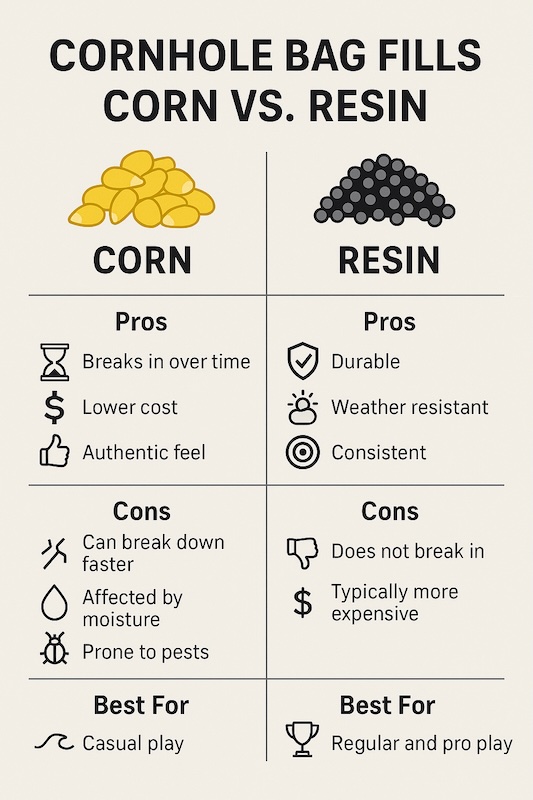What Are Cornhole Bags Filled With? A Complete Guide

If you’re new to the game of cornhole, you might be surprised to learn that the bags themselves are just as important as the boards. While most casual players are familiar with the standard square bags tossed around at backyard barbecues, few stop to wonder: what exactly are cornhole bags filled with? The answer is more interesting than you might think, and it reveals a lot about the evolution of the game from a casual lawn pastime to a professional sport.
In this post, we’ll break down the different types of fillings used in cornhole bags, why they matter, and how the choice of material affects gameplay.
The Traditional Fill: Whole Kernel Corn
As the name suggests, cornhole bags were originally filled with corn. Specifically, most early bags were filled with dried whole-kernel feed corn. This wasn’t just convenient—corn was inexpensive, widely available, and had a weight and texture that worked well for tossing onto wooden boards.
Corn-filled bags provide a very distinct playing experience:
- Break-in factor: Over time, the kernels inside break down into smaller pieces, softening the bag and making it easier to grip and control. Many players enjoy this “broken-in” feel.
- Grip on the board: Corn tends to provide a more inconsistent slide, which can make each game feel unique. On humid days, kernels absorb moisture, making bags heavier and stickier on the board.
- Tradition: For purists, nothing beats the authenticity of a bag filled with real corn.
However, corn does come with drawbacks. Bags filled with corn wear out faster, especially outdoors where moisture, pests, or mildew can ruin the fill. For players who want longevity and consistent performance, this led to the rise of synthetic alternatives.
The Modern Standard: Resin Pellets
Today, professional cornhole bags are almost always filled with plastic resin pellets (often polypropylene). Resin offers several advantages over corn:
- Durability: Resin doesn’t break down over time. Unlike corn, which grinds into dust and changes the bag’s weight and feel, resin maintains a consistent shape and size.
- Weather Resistance: Resin is unaffected by humidity, rain, or pests. You can leave your bags in the garage for months without worrying about mold or mice.
- Consistency: Because the pellets are uniform in size and weight, players get predictable throws and slides every time. This consistency is especially important at the professional level.
Different manufacturers may use slightly different resin blends or pellet sizes, but the principle is the same: synthetic fill ensures reliable performance no matter the conditions.
Specialty Fills and Blends
While most bags use either corn or resin, some bags are made with blended fills to create unique playing characteristics. For example:
- Corn + Resin Mix: A mix of traditional corn kernels and resin pellets gives players the best of both worlds—the nostalgic feel of corn with the durability of resin. These hybrid bags still break in over time, but not as quickly as 100% corn.
- Different Pellet Sizes: Some advanced bags use two different sizes of resin pellets. Smaller pellets create a denser, smoother bag, while larger pellets add texture and grip. By mixing them, manufacturers can fine-tune the bag’s behavior on the board.
These specialty fills are often used by competitive players who are seeking a very specific bag feel to match their throwing style.
How Fill Impacts Gameplay
So why does the choice of fill matter so much? It comes down to how the bag interacts with both your hand and the board:
- Weight: Regulation cornhole bags weigh between 15.5 and 16.5 ounces. Corn and resin can both meet this requirement, but resin tends to maintain its weight longer since it doesn’t break down.
- Feel: Corn-filled bags get softer and “floppier” as they age, which some players love. Resin bags keep a firmer, fuller feel that makes them easier to grip in consistent ways.
- Slide vs. Stick: Corn absorbs moisture, which can slow the bag down on humid days. Resin doesn’t change, so slide speed is more predictable. Many players now rely on the fabric of the bag (slick side vs. sticky side) rather than the fill for controlling slide.
In short, the fill doesn’t just sit inside the bag—it directly influences how you throw, how it lands, and how it plays across different conditions.
Backyard vs. Professional Use
If you’re buying cornhole bags for casual backyard play, corn-filled bags can be a fun and authentic choice. They’re inexpensive, nostalgic, and add some unpredictability that keeps the game lighthearted.
But if you’re planning to play regularly, invest in resin-filled bags. They’ll last far longer, hold up in all weather, and provide consistency that makes improving your skills easier. This is why the American Cornhole League (ACL) and other professional organizations exclusively use resin-filled bags in sanctioned events.
Final Thoughts
So, what are cornhole bags filled with? Traditionally, they were filled with dried whole-kernel corn, which gave the game its name. Today, however, most modern and professional bags use resin pellets for durability and consistent performance. Some manufacturers even experiment with blends to create specialized playing experiences.
At the end of the day, the best fill for you depends on how you play. If you’re looking for casual backyard fun and a taste of tradition, corn might be the way to go. But if you want longevity, reliability, and performance—especially in competitive settings—resin is the clear choice.
Either way, the humble bag fill is more than just “stuffing.” It’s a key ingredient in what makes cornhole such an addictive and endlessly enjoyable game.
